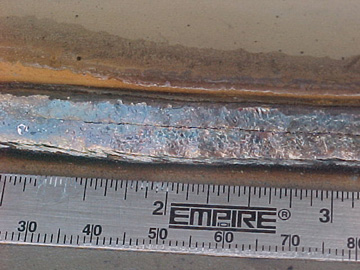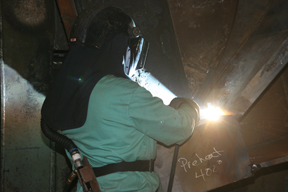Understanding Weld Cracking, Its Causes, Consequences…and Remedies
Whether the result of poor parts fit-up, rapid cooling or a variety of possible contaminants—from the atmosphere, base material or filler metal—weld cracking carries with it significant consequences for any welding operation. Not only does this defect adversely affect the integrity of the finished weldment, but it also requires significant time and money to rectify. In a best-case scenario, a welding operator must remove the weld crack by carbon arc gouging (or other means) and repair the weld, while in other instances the welded part must be completely rejected and scrapped.
In critical applications, companies can also incur significant costs for inspecting welds that may ultimately be rejected if a crack is present. Once reworked, these parts require a second round of testing that inevitably increases the company’s cost for this portion of the operation. In the case of products that need to be post-weld heat treated (PWHT), hours or even days must pass between the completion of the rework and a new evaluation, adding to a company’s overall downtime and lost productivity. For companies that must meet contract terms, such delays can even result in fines for missed deadlines.
Fortunately, weld cracking doesn’t have to be a complete enigma—or a total drain on a company’s productivity or profit. Understanding the basic types of weld cracks and their causes can go far toward preventing them in the first place.
Beat the Heat: Hot Cracking at a Glance
Hot weld cracking occurs at high temperatures—generally over 1000 degrees Fahrenheit (538 degrees Celsius)—and the defect appears more or less immediately (though not always visibly) upon solidification of the weld. Hot cracking is almost always appears in the longitudinal direction of the weld bead itself, or directly adjacent to it. Hot cracking can also appear intermittently along the weld’s length.
There are two main types of hot cracking: centerline and crater, with the first being further divided into either segregation or bead shape cracking.
As indicated, centerline cracking occurs through the center of the weld, and in the case of segregation cracking, is the result of elements with low melting points being rejected to the center of the weld upon solidification. Materials, such as free machining steels (due to their high sulfur and phosphorous content), are especially susceptible to segregation cracking as are materials with zinc plating, galvanized coatings or those covered with paints or primers. Certain alloys found in filler metals may also be responsible for the problem. For example, boron, which is added to many filler metals to help refine grain structure can, in excess, cause segregation cracking.
The second type of centerline cracking—bead shape cracking—occurs as the result of poor part fit-up or a poor joint design. To compensate for these conditions, welding operators often create a wide weld bead with a thinner throat, which makes the finished weld weaker and puts undue stress on the centerline, in turn causing a crack. Welding at high voltages, especially with an electrode or welding wire that creates a particularly fluid weld pool can also cause the resulting weld bead to be more concave. This again reduces the throat thickness and weld strength, making it more prone to bead shape cracking. Similar results can occur from the presence of shallow craters as well.

low melting point material segregation (or segregation weld
cracking).
Crater cracking occurs when the welding operator stops welding prior to finishing a pass on a weld joint, leaving a wide, thin depression at the end. It can also appear in areas that have been tack welded when the corresponding weld passes does not meet fully against the tacks. In both instances, using a backfill technique—backing up slightly to fill in the area at the end of the weld—can help prevent the problem by adding greater thickness to the crater.
For all the aforementioned reasons, careful filler metal and base material selection, as well as good parts fit up, proper joint design and thorough welding techniques are all essential to avoiding hot weld cracking.
Hydrogen HAZards: A Closer Look at Cold Cracking
Unlike hot cracking, cold weld cracking occurs at temperatures well below 600 degrees Fahrenheit (316 degrees Celsius) and does not appear until hours, even days, after the weld cools. Also, most cold cracking begins in the base metal instead of the weldment itself and passes transversely into the weld as it progresses. Cold cracking is often referred to as hydrogen-induced and/or heat-affected zone (HAZ) cracking.
Broadly speaking, cold cracking occurs in the HAZ as the result of residual stresses from the base material restraining the weld, along with the presence of diffusible hydrogen. Cold cracking is particularly prevalent in thick materials, as they tend to create areas of high restraint and can serve as a heat sink that leads to fast cooling rates. Such rapid cooling cause the microstructure in the HAZ to form a new crystalline microstructure called martensite. While very hard, martensite is also very brittle and lacks ductility. Martensite provides a location for diffusible hydrogen to coalesce, which in turn creates residual stresses that build in the HAZ. Once these residual stresses reach a critical level, cold cracking occurs.
Hydrogen can be introduced to the weld via the filler metal, the base material or the atmosphere. While hydrogen is quite soluble in molten or nearly molten weld metal, as the weld cools it will naturally begin to diffuse out of the area. As alluded to previously, any hydrogen that remains in the weld then gathers around the martensitic crystals or other imperfections in the HAZ, increasing pressure on the microstructure and causing a crack. This hydrogen diffusion can take hours or days to occur, hence cold cracking’s delayed appearance.
Materials prone to cold cracking include those with high carbon and/or high alloy levels and which are therefore also higher in strength. Such materials, especially thicker ones, are generally less ductile and tend to shrink after welding, which causes additional residual stresses that lead to cracking.
Techniques like back stepping can help prevent cold cracking. To perform this technique, the welding operator welds in one direction for a short length, returns to prior to the beginning of the last weld and repeats the weld pass, stopping at the start of the first weld. In essence, the heat of the subsequent weld pass serves as a type of stress relieving. The best defense against cold cracking, however, is proper pre- and post-weld heat treatments, along with general practices that minimize the exposure to hydrogen sources (these will be discussed in detail in the following section).
Pre-heating the base metal prior to welding slows down the cooling rate, allowing more time for hydrogen to diffuse from the weld, and it also forms a more ductile, less hard microstructure often referred to as pearlite. Pearlite forms a the expense of martensite and is much less susceptible to the damaging effects of hydrogen.
Similarly holding the finished weld at a given temperature for period of time (via a process like induction heating) slows the cooling process, allowing hydrogen to diffuse more readily and limiting the chance of cold weld cracking.PWHT reduces the propensity for cold cracking by both relieving residual stresses and driving the diffusible hydrogen from the weldment. Once released, hydrogen cannot naturally diffuse back into the weldment. Note that rapid heating and cooling rates during PWHT generate thermal gradients that can increase residual stresses and lead to cracking just before the full benefits of PWHT are realized.
Other Best Defenses: Selecting and Storing Filler Metals
In addition to the aforementioned techniques, proper filler metal selection and storage can also help prevent costly weld cracking, especially cold cracking.
In particular, using filler metals that feature a low hydrogen designator, such as H4 or H8, are a good defense against cold cracking. These designators indicate that the product offers low diffusible hydrogen levels, or in these examples, less than 4 or 8 mg of hydrogen per 100 g weld metal.
Filler metals with a basic slag system can similarly mitigate the risk of cracking, as they have a high volume of hydrogen scavengers (fluoride, sodium and calcium, for example) that are able to combine with hydrogen, removing it from the solidifying weld. Note, despite having large amounts of hydrogen scavengers, products with a basic slag system typically cannot be used for out-of-position welding. They also tend to have more challenging operating characteristics than those with an acidic slag system.
Filler metals should be stored in a dry area and remain in the packaging in which they were received from the filler metal manufacturer until ready for use. Ideally, that packaging should be heat- and/or vacuum-sealed to block moisture from reaching the product. The storage area should also be similar in temperature to the environment in which the welding will take place; storing the filler metal in a cold area and moving it to a hot one can lead to condensation, increasing the chance of hydrogen pickup in the weld. If a storage area of similar temperature is not available, allowing the filler metal to acclimate to the temperature of the welding environment before opening the package can help minimize the risk of condensation and subsequent chances of cracking.
Unfortunately, even the best filler metals and the most appropriate storage practices are not guaranteed defenses against cold cracking. Hydrogen can still be absorbed into the weld via the atmosphere, especially in high humidity areas, or by contaminants on the base metal, particularly rust, mill scale, oils, lubricants and primers. Defective gas lines or connections can also cause shielding gases to have a high dew point and therefore, greater amounts of hydrogen. For all of these reasons, care must be taken throughout the welding process to avoid these additional hydrogen sources.
The bottom line: weld cracking costs money, no matter what type it is. And it can mean the difference between a solid competitive edge and profit for a company or ongoing rework and low productivity. Fortunately, as with any part of the welding process, knowledge is the key to understanding the problem—and to solving it.



